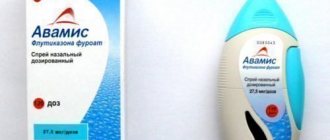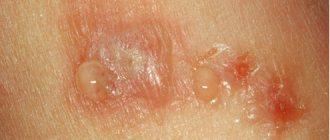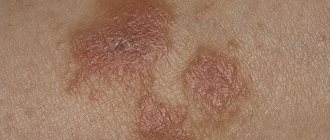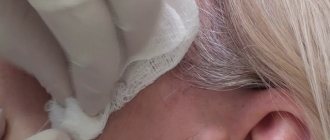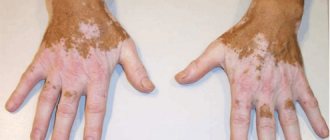Psoriasis is a non-infectious chronic disease that occurs in waves. It causes inconvenience to a person not only due to problems with the health of the body, but also from an aesthetic point of view. During illness, nails begin to peel and change color, spots and wounds appear on the skin around the nail plate. Nail psoriasis can often cause pain. Treatment usually takes a lot of time and effort. People who are faced with this disease are usually concerned about how to treat nail psoriasis and what rules of behavior should be followed. You can find out the answers to them by reading this article.
Causes of psoriasis
Nail psoriasis occurs much less frequently than all other types of this disease. It can develop on the basis of existing lesions in certain areas of the skin or psoriatic arthritis, or it can be an independent disease. Doctors still do not have a common opinion about the causes of psoriasis.
Causes of nail psoriasis may include the following:
- Prolonged stress.
- Metabolic disorder.
- Peripheral circulation disorders.
- Increased sensitivity to certain environmental factors.
- Inherited predisposition.
Nail psoriasis: symptoms
A disease such as psoriasis has been known for a long time. Back in the nineteenth century, the main signs characterizing nail damage in psoriasis were described, and the difficulties of diagnosis were also noted. Even then, doctors assumed that this disease had an isolated form. Nowadays, this assumption has been confirmed. In the case of vulgar psoriasis, damage to the nail plates can occur as a concomitant form, or it can also develop separately. The diagnosis is made, for the most part, on the basis of diagnosing the appearance of the nail plates of the hands and feet. Sometimes an additional biopsy and histological analysis of tissue from the affected areas is performed.
In most cases, nail psoriasis does not cause changes in blood composition or deviations from the norm. The exception is a severe form of the disease, during which leukocytosis may begin, as well as an increase in the erythrocyte sedimentation rate.
The main clinical manifestations of psoriasis are trachyonychia, onycholysis, subungual hemorrhages and the thimble symptom. The presence of any of them determines the specifics of what nail psoriasis looks like. Let's look at them in more detail.
Subungual hemorrhage
There are two types of subungual hemorrhage, which differ in their varied characteristics. In the first case, patients are faced with the appearance of spots on the nail plate that have different colors and sizes. The disease presented is called oil stain syndrome.
In the second case, subungual hemorrhages are characterized by stripe-like hemorrhages of reddish, brown or black shades. This type of disease develops after blood capillaries rupture.
Thimble symptom
Thimble is the most common type of nail psoriasis. The manifestation of this symptom is the appearance on the nails of small depressions of various shapes with a diameter of 0.5 to 2 mm. These pits appear due to pathological nail formation. They appear on the nail in a chaotic manner and resemble the outer surface of a thimble in appearance. Similar deformations of the nail plate also occur in the case of other dermatological diseases, but such pits can appear individually in healthy people.
Thimble Syndrome
This is a common form of nail psoriasis. This problem manifests itself in the form of tiny dimples on the surface. Their diameter reaches two millimeters. The main reason for the development of this form of the disease is a violation of the formation of the plate. The recesses can have different sizes, shapes and depths. They are also , which in appearance is more similar to the surface of a thimble. That is why this disease received this name.
If a person has one or two dimples, then this phenomenon is considered normal and the problem is not classified as nail psoriasis. A similar form of the disease can appear during chronic dermatosis.
Onycholysis
Onchiolysis is a nail lesion that also often occurs during psoriasis. During onchiolysis, the nail plate begins to separate smoothly and without accompanying pain and inflammation from the bed. According to the degree of its severity, this symptom, which often occurs with a disease such as nail psoriasis, can be complete or partial. In most cases, detachment begins at the distal edge, but central and lateral onchiolysis are also common.
When the nail plate begins to peel off, dirt, air and dust enter the resulting empty space. There are also particles of exfoliated epidermis located there, which is why the nail changes color to light gray, and in some cases, to brown-yellow. The distinctive feature of this form of psoriasis is a thin pink line around the affected area, which becomes yellowish over time. Often during onchiolysis, the affected nails begin to emit an unpleasant odor.
Diagnostic features
Often, the diagnosis of psoriasis is complicated by the fact that many of the above symptoms are also present in other dermatological diseases, in particular some fungal infections. Such confusion can arise, for example, if there are no characteristic plaques on the patient’s body that make it possible to clearly judge psoriasis.
So, nail psoriasis or fungus? How to distinguish nail psoriasis from fungus? The main difference lies in the nature of the diseases. The fungus is contagious and can be easily transmitted from sick to healthy people through direct contact or through the use of common household items. Patients with psoriasis are not dangerous in this regard.
As for visual or other tangible differences, there are several. With fungal infections, the scales around the affected nails are more easily separated from the skin, which is not typical for the initial stage of psoriasis. Further: separation of the nail from the base during psoriasis does not entail its deformation and is not accompanied by pain, as with candidiasis or mycoses. Another difference between psoriasis is the absence of an unpleasant odor, characteristic of candidiasis.
Psoriatic lesions can also be observed with other skin diseases, such as pityriasis rosea, seborrheic eczema. Moreover, their appearance is also likely in diseases from a completely different story - hypertension, pulmonary and heart failure, diabetes mellitus. Nail psoriasis or psoriatic onychodystrophy can also develop due to stress, chronic fatigue, emotional distress, taking beta-blocking drugs and other medications.
Of course, making an accurate diagnosis is the prerogative of a specialist. Very often, for this, the presence of external signs alone is not enough - differential diagnosis is required using additional research methods. For example, bacterial analysis (culture) of scales of affected areas, direct microscopy.
From all this, an obvious conclusion arises: at the first suspicion of psoriasis of the nails of the fingers or toes, you must immediately contact a qualified specialist! More information about whose functions include the treatment of psoriasis on the arms or legs is below.
Trachyonychia
This is another type of nail psoriasis, which manifests itself in the form of changes in the color and texture of the nail plate: during trachyonychia, it becomes dull and rough, and the hole located at its base disappears. Sometimes during tracheonychia the nail seems to be pressed in the center: this pathology is called koilonychia. At the same time, at the very beginning of the disease, before acquiring such a curved shape, the nails become somewhat flattened. The tissues located under the nail do not undergo changes.
Nail psoriasis: treatment
This disease takes a long time to cure. The most important thing that should not be forgotten during therapy is the need to use an integrated approach to treatment. Treatment of psoriasis of the fingernails and toenails is prescribed by a doctor in accordance with the clinical picture of the disease, its severity, taking into account the patient’s tendency to relapse, the presence of concomitant diseases and a person’s individual tolerance to certain medications. If the disease is at an early or middle stage, local medications are taken for treatment:
- Creams and ointments containing corticosteroids - Triacort, Triamcinolone, Prednisolone ointment. This is the main group of medications suitable for the treatment of psoriasis.
- Preparations containing vitamin D3 - “Tacalcinone”, “Calcitriene” and others. They help inhibit the division of cells affected by the disease. They combine well with drugs containing betamethasone, for example, Taklonex ointment.
- Tar or coal tar is a slightly weaker analogue of the drugs described in the paragraph above.
- Dermatotropic drugs - Micanol, Antralin, Ditranol. They slow down the division and formation of cells that form the manifestations of psoriasis and can contribute to stable and long-term remission of the disease.
- External retinoids – “Tazarotene”, “Tazorak”. They are effective for mild to moderate nail psoriasis.
- Salicylic acid - helps enhance the effect of other medications, relieves itching and plaque, and also exfoliates dead tissue.
- A solution of 5-fluorouracil, which is applied under a bandage around the finger. Requires long-term treatment - up to six months.
If treatment with local drugs is ineffective, the doctor selects a course of systemic therapy for the patient, which includes the following medications:
- Cyclosporine is a fairly effective remedy for the treatment of psoriasis of any degree of complexity. After completing a course of treatment, Neoral is required as maintenance therapy for two years. "Neoral" includes the same active ingredient as "Cyclosporine", but in a lower content.
- Methotrexate is a strong drug that is prescribed for generalization of the disease process. Before use, be sure to read the instructions: Methotrexate has a large number of side effects and contraindications.
- “Acitretin” and “Isotretinoin” are prescribed for severe and advanced forms of nail psoriasis.
- Antidepressants - used to reduce itching and stress reactions.
- Complexes of vitamins and minerals that enhance immunity. They must include elements such as calcium, zinc and selenium.
Consequences
Psoriasis is not completely cured, but only put into remission. The disease is prone to relapses, which become more severe each time. If skin pathology is not treated, it will provoke dangerous consequences.
Any form of psoriasis affects the state of the cardiovascular system, which can ultimately lead to myocardial infarction. This dermatosis aggravates the course of atherosclerosis and inflammatory processes in the body.
Psoriasis threatens a person’s emotional and psychological health with serious consequences. Nervous breakdowns, depression and alcohol abuse are common companions for patients with psoriasis. The result of such disorders can be diabetes mellitus, heart disease, cancer of any location, and aggravation of concomitant chronic pathologies.
Nail psoriasis and bad habits can cause heart problems
In addition to distortion of the nail plate, severe stages of the disease can cause negative disturbances in the general condition of a person:
- jumps in body temperature;
- disruptions in the normal absorption of folic acid;
- weakness and constant fatigue.
Important!
It is important not to bring the pathology to a critical state, when the affected nails and skin begin to become covered with ulcers and rot (Zumbusch psoriasis).
Modern methods of treating nail psoriasis
Modern areas of treatment for nail psoriasis include:
- The use of multichannel antibodies, such as Rituximab and Ustekinumab. By contacting the immune system, they destroy immature cells that form manifestations of psoriasis.
- Use of biological response modifiers, for example, Alefacept. Such drugs selectively affect those cells of the immune system whose functions have been impaired.
- Necrosis blockers - Adadlimumab, Etanercept. They are used to treat advanced stages of psoriasis.
Stages of the disease
In general, abnormal manifestations that later develop into psoriasis go through three main stages:
- The first of them is characterized by darkening and clouding of the nail, transverse or longitudinal stripes, depressions, and specks appear on it;
- At the second stage, the nail thickens, changes its shade, acquiring a yellowish, gray, chestnut color. Sometimes this is accompanied by hemorrhagic manifestations with the appearance of bloody streaks and purulent foci;
- At the last stage, oily spots and plaques appear on the plate. The nail completely atrophies and begins to peel off. Often these negative manifestations are accompanied by all kinds of bacterial and fungal infections.
Nail psoriasis: treatment with folk remedies
It often happens that many medications cause allergies. These circumstances force us to resort to the following solution to such a problem as nail psoriasis: treatment with folk remedies.
Well-proven folk methods for treating psoriasis include:
- Nail baths with bay leaves. To prepare the solution, pour 20 grams of bay leaf into two glasses of boiling water. Boil the resulting mixture for 10-12 minutes, let it cool and keep your nails in it for 10-15 minutes. The solution can also be taken orally: 40 milliliters 3 times a day.
- Lotions: mix 500 milliliters of water with 2 tablespoons of corn starch or oatmeal and apply to the affected area.
- Herbal baths made of sage, oak bark, string and celandine.
- Taking an infusion of St. John's wort, string, lingonberry leaves and calamus root also helps cure nail psoriasis. These herbs need to be mixed in equal parts, pour one spoon of the resulting mixture with a glass of boiling water and take 50 milliliters twice a day.
- Durushnik compresses: pour 4 tablespoons of crushed leaves into 500 milliliters of water, distribute the brewed herb evenly over the affected areas of the body, wrap with cling film and hold for 15 minutes.
These folk remedies for eliminating nail psoriasis will be of great help to people who, due to certain circumstances, cannot take medications. But, nevertheless, before starting a course of treatment you still need to consult a doctor.
Diet for nail psoriasis
Treatment of nail psoriasis is impossible without following the necessary nutrition and diet. If possible, you should completely stop drinking alcohol and smoking. During treatment, it is necessary to avoid fried, smoked and salty foods, fatty and dairy products, nuts, chocolate, citrus fruits, carbonated drinks, strong tea and coffee, as well as nightshade vegetables - eggplants, potatoes, tomatoes and sweet peppers.
The diet of a patient with psoriasis should include at least 30% acidic foods and about 70% alkaline foods. It is recommended to consume at least 2 liters of water per day, boiled cereals, lean meat and fish, vegetables, eggs, sweet fruits, juice and herbs.
Rules of conduct for psoriasis
In order to cure the disease as soon as possible, the following rules of conduct must be observed:
- Nails should be cut short and neat.
- When using household chemicals, you need to wear gloves on your hands.
- Prevent mechanical damage to nails, refuse manicures and pedicures.
- Lubricate your hands with a cream that nourishes your skin and nails.
- Make baths with herbs.
- Avoid stressful situations.
Now you know how to treat nail psoriasis, what symptoms it is accompanied by, and what precautions should be taken to prevent it.
Preventive measures
To combat this insidious and difficult-to-treat disease, it is necessary to constantly follow preventive measures, in particular:
- Carefully observe hand and foot hygiene;
- Protect hands and feet from direct contact with chemicals;
- Avoid hypothermia and infections, take care of your own immune system;
- Protect nail plates from mechanical damage;
- Take precautions when using manicure accessories, do not use artificial materials for nail extensions and use medicinal antibacterial varnishes;
- Be especially careful during exacerbations of the disease, paying attention, among other things, to diet - excluding fatty, floury, and sweet foods from the diet. The menu should be dominated by fresh vegetables and fruits, fish dishes, fermented milk products, and liver.
Remember! The worst enemies of antipsoriatic therapy are alcohol and tobacco!
Psoriasis does not disappear completely and irrevocably. Even when it seems that its symptoms are no longer observed, the risk of relapse remains constant. Unfortunately, we have to admit: psoriasis is a disease that must be put up with throughout your life. Another thing is that by adhering to a healthy lifestyle and following medical instructions, there is a high probability of increasing the duration of remission periods - up to tens of years!



